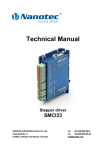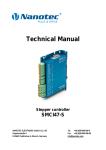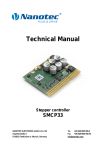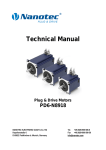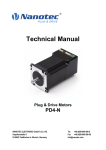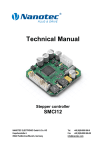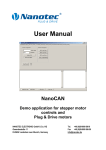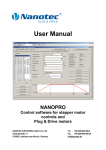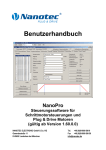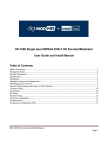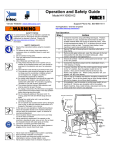Download SMCI33 Technical Manual V2.2
Transcript
Technical Manual Stepper motor control SMCI33 NANOTEC ELECTRONIC GmbH & Co. KG Gewerbestraße 11 D-85652 Landsham near Munich, Germany Tel. +49 (0)89-900 686-0 Fax +49 (0)89-900 686-50 [email protected] Technisches Handbuch SMCI33 Editorial Editorial © 2010 Nanotec® Electronic GmbH & Co. KG Gewerbestraße 11 D-85652 Landsham / Pliening, Germany Tel.: Fax: +49 (0)89-900 686-0 +49 (0)89-900 686-50 Internet: www.nanotec.de All rights reserved! MS-Windows 2000/XP/Vista/7 are registered trademarks of the Microsoft Corporation. Version/Change overview 2 Version Date Changes 1.0 02/20/2009 New issue C+P 2.0 07/01/2009 Revision C+P 2.1 04/08/2010 Revision C+P 2.2 11/08/2010 Revision C+P Issue: V 2.2 Technisches Handbuch SMCI33 About this manual About this manual Target group This technical manual is aimed at designers and developers who need to operate a Nanotec® stepper motor without much experience in stepper motor technology. Important information This technical manual must be carefully read before installation and commissioning of the stepper motor control. Nanotec® reserves the right to make technical alterations and further develop hardware and software in the interests of its customers to improve the function of this product without prior notice. This manual was created with due care. It is exclusively intended as a technical description of the product and as commissioning instructions. The warranty is exclusively for repair or replacement of defective equipment, according to our general terms and conditions, liability for subsequent damage or errors is excluded. Applicable standards and regulations must be complied with during installation of the device. For criticisms, proposals and suggestions for improvement, please contact the above address or send an email to: [email protected] Additional manuals Please also note the following manuals from Nanotec: NanoPro User Manual Configuration of controllers with the NanoPro software Programming manual Controller programming • Command reference • NanoJ • COM interface The manuals are available for download at www.nanotec.com. Issue: V 2.2 3 Technisches Handbuch SMCI33 Contents Contents 1 Overview ............................................................................................................................... 5 2 Connection and commissioning ........................................................................................ 6 2.1 Connection diagram ............................................................................................................... 6 2.2 Commissioning....................................................................................................................... 8 3 Connections and circuits .................................................................................................. 10 3.1 Inputs and outputs (I/O): Connector X1 ............................................................................... 10 3.2 Encoder connection: Connector X2 ..................................................................................... 12 3.3 Stepper motor connection: Connector X3............................................................................ 13 3.4 Voltage supply connection: Connector X4 ........................................................................... 14 3.5 RS485 network: connector X5 ............................................................................................. 15 4 Operating modes................................................................................................................ 17 5 Troubleshooting................................................................................................................. 19 6 Technical data .................................................................................................................... 20 Index ...................................................................................................................................................... 22 4 Issue: V 2.2 Technisches Handbuch SMCI33 Overview 1 Overview Introduction The stepper motor control SMCI33 is an extremely compact and cost-effective constant current power output stage with integrated Closed-Loop current control. Due to the great capacity and functions available, it offers designers and developers a rapid and simple method of resolving numerous drive requirements with less programming effort. It is used for controlling standard stepper motors (including with attached encoders) or motors with integrated encoders or brakes. Variants The SMCI33 is available in the following variants: • SMCI33-1: with USB interface (drivers necessary) • SMCI33-2: with RS-485 interface SMCI33 functions The stepper motor control SMCI33 contains the following functions: • Microstep -1/1 – 1/64 final output stage (step resolution of up to 0.014° in motor with a step angle of 0.9° in 1/64 step mode) • Closed-Loop current control (sinusoidal commutation via the encoder) • Rotation monitoring for optional encoder • RS485 or USB interface for parameterisation and control • Sequence programs with NanoJ • Network capability up to 254 motors • Easy programming with the NanoPro Windows software Closed-Loop current control (sinusoidal commutation via the encoder): In contrast to conventional stepper motor positioning controls where only the motor is actuated or the position adjusted via the encoder, sinusoidal commutation controls the stator magnetic field via the rotary encoder as in a servomotor. The stepper motor acts in this operating mode as nothing more than a high pole servomotor, i.e. the classic stepper motor noises and resonances vanish. As the current is controlled, the motor can no longer lose any steps up to its maximum torque. If the controller recognizes that the rotor is falling behind the stator field due to overload, adjustments are made with optimal field angle and increased current. In the opposite case, i.e. if the rotor is running forward due to the torque, the current is automatically reduced so that current consumption and heat development in the motor and controller are much lower compared to normal controlled operation. Issue: V 2.2 5 Technisches Handbuch SMCI33 Connection and commissioning The integrated programming language NanoJ, based on the Java standard, means complete application programs can be realized on the drivers that can be executed independently without a higher-order controller. The programs can be created, compiled directly and written to the controller with the free NanoJEasy editor. NanoJ is only supported by the RS485 firmware. More detailed information can be found in the separate programming manual. Settings The operating behavior of the motor can be set and optimized according to individual requirements by setting the motor-related parameters. The parameters can be set using the NanoPro software and significantly reduce commissioning time. More detailed information on this can be found in the separate NanoPro user manual. Rotation monitoring Even if stepper motors do not lose steps during normal operation, the integrated speed control provides additional security in all operating modes, e.g. against motor stalling or other external sources of error. The monitoring function detects a stalled motor or step loss after half a step at the most (for 1.8° stepper motors). Automatic error correction is possible after the drive profile is ended or during the drive. 2 2.1 Connection and commissioning Connection diagram Introduction To operate a stepper motor with the SMCI33 stepper motor control, the wiring must be implemented according to the following connection diagram. Inputs (Pin 1 to 6) on the connector X1 and the encoder input (connector X2) can be used optionally. 6 Issue: V 2.2 Technisches Handbuch SMCI33 Connection and commissioning Connection diagram SMCI33 Issue: V 2.2 7 Technisches Handbuch SMCI33 Connection and commissioning 2.2 Commissioning Introduction The connection and commissioning of the SMCI33 stepper motor are described below. This section describes the main first steps you need to take to be able to quickly begin working with the SMCI33 if you are using the NanoPro software from a PC. You will find more detailed information in the separate NanoPro manual. If you want to work at a later time with a PLC or your own program, you will find the necessary information in the separate "Command Reference". Familiarize yourself with the SMCI33 stepper motor control and the corresponding NanoPro control software before you configure the controller for your application. Procedure Proceed as follows to commission the controller: Step Action Note 1 Install the NanoPro control software on your PC. Download of www.nanotec.com See the NanoPro separate manual. 2 Connect the controller to the stepper motor according to the connection diagram. Connection diagram, see Section 2.1. Detailed information on connections can be found in Chapter 3. 3 Switch on the operating voltage (24 V DC ... 48 V DC). The green LED lights up. 4 If necessary, install the USB driver and the driver for the converter cable ZK-RS485-USB. Download www.nanotec.com in the Support/Download/Driver menu item 5 CAUTION! Danger of overvoltage at the USB interface. When using notebooks connected to the line supply, detach the power cable before connecting the USB cable. 6 Connect the controller with your PC. Order number: Use one of the following converter cables for this • ZK-RS485-RS232 purpose: • ZK-RS485-USB • ZK-RS485-RS232 for connection to the serial interface • ZK-RS485-USB or conventional USB cable, type MINI-B, for connecting to the USB interface (for SMCI33-1) 8 Issue: V 2.2 Technisches Handbuch SMCI33 Connection and commissioning Step Issue: V 2.2 Action Note 7 Start the NanoPro software. The NanoPro main menu appears. 8 Select the <Communication> tab. 9 In the field "Port", select the COM port to which the SMCI33 is connected. 10 Select the "115200 bps" entry in the "Baudrate" selection field. 11 Check the current setting using the motor data sheet. 12 Select the <Mode> tab. 13 Click on the <Test Record> button to carry out the pre-set travel profile. The connected motor operates with the pre-set travel profile (default travel profile after new installation). 14 You can now enter your required settings. For instance, you can enter a new travel profile. See the NanoPro separate manual. The number of the COM port to which the controller is connected can be found in the device manager of your Windows PC. (System control/system/hardware). Under no circumstances may the current be set to a value higher than the rated current of the motor. 9 Technisches Handbuch SMCI33 Connections and circuits 3 3.1 Connections and circuits Inputs and outputs (I/O): Connector X1 Introduction An overview of the assignments can be found in the wiring diagram in Section 2.1). This section looks in detail at the assignment, functions and circuits of the connector X1. The connectors and sockets used are from Phoenix, order number: FK-MC 2/4/5/12. Connection diagram Pin assignment Pin no. Name Observations 1 Input 1 5-24 V Optocoupler 2 Input 2 5-24 V Optocoupler 3 Input 3 5-24 V Optocoupler 4 Input 4 5-24 V Optocoupler 5 Input 5 5-24 V Optocoupler 6 Input 6 5-24 V Optocoupler 7 Com Signal GND 8 Output 1 Open-Collector 9 Output 2 Open-Collector 10 Output 3 Open-Collector 11 Analog In –10 V ... +10 V 12 GND Power & Analogue GND Note: Com and GND connection are not connected. Com is the ground connection for the inputs and GND is the ground connection for outputs and the internal circuitry. 10 Issue: V 2.2 Technisches Handbuch SMCI33 Connections and circuits Function of the inputs All digital inputs – with the exception of the "Clock" input in the clock directional mode – can be freely programmed using the NanoPro software (e.g. as a limit position switch, enable, etc.) and can be used for sequential control with NanoJ. All inputs can be configured for “active-high" (PNP) or “active-low" (NPN) with NanoPro. Input circuits All inputs (apart from the "Analogue In" input) are electrically isolated by optocouplers from the voltage supply of the SMCI33 and designed for 5 - 24 V input signals at an input current of 10 mA. Note: The voltage must not exceed 24 V. It should drop below 2 V for safe switching off and be at least 4.5 V for safe switching on. Output circuits The outputs are transistor outputs in Open-Collector circuits (0 switching, max. 30 V / 30 mA). An LED can be integrated to test the output. The LED lights up when the output is active. Issue: V 2.2 11 Technisches Handbuch SMCI33 Connections and circuits 3.2 Encoder connection: Connector X2 Optional encoder An optional encoder can be connected to the stepper motor control. By default, the closed-loop control for a three-channel encoder is set up with 500 pulses/revolution in an 1.8° stepping motor. With an 0.9° stepper motor, you should use an encoder with 1000 pulses/revolution to achieve the same control quality. Depending on the application, it may make sense to use higher encoder resolutions (up to max. 2000 pulses/revolution) to improve control quality or to use a lower resolution (min. 200 pulses/revolution) for low-cost applications or for step monitoring alone. The following encoder resolutions can normally be processed by the controller: 192, 200, 256, 400, 500, 512, 1000, 1024, 2000, 2048. Recommended: Where possible, use Nanotec encoders with the order number WEDS/WEDL-5541 Xxx. If an encoder is not used, the "Disable" mode must be set in the "Error correction" tab in the "Rotation Direction Mode" selection menu. See the NanoPro separate manual. Using encoders with line drivers The encoders of the WEDL series with a line driver output an inverted signal in addition to the encoder signal; this leads to better interference immunity and is especially recommended for long lines lengths. We recommend shielding and twisting the encoder line to minimize interference with the encoder signal from the outside. To be able to connect negative signals to the SMCI33, you require adapter ZK-SMCI-LD. Encoder connection diagram (X2) Note: Complete connection diagram, see Section 2.1. Pin assignment connector X2: Encoder Pin no. 12 Name 1 +5 V 2 Track (B) 3 Track (A) 4 Index track (I) 5 GND Observations Issue: V 2.2 Technisches Handbuch SMCI33 Connections and circuits 3.3 Stepper motor connection: Connector X3 General information The motor is connected to the SMCI33 with a 4-wire cable. Twisted wire pair cables with braided shields are recommended. Danger of electrical surges Mixing up the connections can destroy the output stage! See also the data sheet of the connected stepper motor. Never disconnect the link when operating voltage is applied! Never disconnect lines when live! Connection diagram Note: Complete connection diagram, see Section 2.1. Pin assignment connector X3: Stepper motor Pin no. Name Observations 1 A 2 A/ See the data sheet of the connected stepper motor. 3 B/ 4 B Motor with 6 or 8 connections If you are using a motor with 6 or 8 connections, you need to connect the windings. The pin configuration for the motor can be found on the motor data sheet, which can be downloaded from www.nanotec.de. Issue: V 2.2 13 Technisches Handbuch SMCI33 Connections and circuits 3.4 Voltage supply connection: Connector X4 Permissible operating voltage The permissible operating voltage for the SMCI33 stepper motor control lies between +24 and +48 V DC; it must not exceed 50 V or fall below 21 V . A charging condenser with minimum 4700 µF (10000 µF) must be provided for the operating voltage to prevent exceeding the permissible operating voltage (e.g. during braking). Danger of electrical surges Connect charging condensor with minimum 4700 µF! Connect a condenser with 10000µF for motors with flange size 86x86 (series ST8918) or greater! An operating voltage > 50 V will destroy the output stage! Mixing up the connections can destroy the output stage! Never disconnect the link when operating voltage is applied! Never disconnect lines when live! Connection diagram voltage supply (X4) Note: Complete connection diagram, see Section 2.1. Pin assignment Pin no. Name Observations 1 Vcc Operating voltage +24 V DC ... +48 V DC 2 GND Earth (0 V) Accessories for voltage supply Appropriate power packs and charging condensers are available as accessories: Name Order identifier Power pack NTS-xxV-yA (xx=voltage: 24 or 48 V, y=current: 2.5, 5 or 10 A) Information on the selection of the required power supply unit can be found in our FAQ on www.nanotec.de. Charging condenser Z-K4700 or Z-K10000 Note: Further information about accessories can be found on the Nanotec website: www.nanotec.com 14 Issue: V 2.2 Technisches Handbuch SMCI33 Connections and circuits 3.5 RS485 network: connector X5 SMCI33 in a network Up to 254 stepper motor controls can be controlled in a network from a PC or PLC. These network connections are set up via the RS485 interface. D-sub socket connector A 9 pin D-Sub socket connector is located on the top of the SMCI33 (connector X5). The connector X5 provides the optional connection to the RS485 network. Pin assignment connector X5: RS485 interface Pin no. Name Observations 1 NC Not assigned 2 Rx+ RS-485 Rx+ 3 +5 V Output +5 V 4 Tx+ RS-485 Tx+ 5 NC 6 NC 7 Rx– RS-485 Rx– 8 GND Output GND (0 V) 9 Tx– RS-485 Tx– Two-wire operation To enable RS485 two-wire transmission capability, all bus stations must have a direction control. An intelligent converter, which automatically switches to transmission mode when a start bit is received at the RS-232 interface and returns to reception mode at the end of the stop bit, enables two-wire operation of the SMCI33. This solution does not require software support. We can recommend the ICP-7520 converter, for example, that is available from Schuricht. Talk to our Technical Hotline if you require support for this. Issue: V 2.2 15 Technisches Handbuch SMCI33 Connections and circuits Circuit diagram RS485 network 16 Issue: V 2.2 Technisches Handbuch SMCI33 Operating modes 4 Operating modes Introduction Depending on the travel profile, the motor can be operated using different operation modes. Due to the great capacity and functions available, it offers designers and developers a rapid and simple method of resolving numerous drive requirements with less programming effort. Select the required operating mode for each drive profile and configure the controller according to your requirements. More detailed information can be found in the separate NanoPro manual. Overview of operating modes and their areas of application Operation mode Application Relative positioning Use this mode when you wish to travel to a specific position. The motor travels according to a specified drive profile from a Position A to a Position B. Absolute positioning Issue: V 2.2 Internal reference run During the internal reference run, the motor travels to an internal reference point at the set minimum speed (index mark of encoder, only in combination with an encoder). External reference run During an external reference run, the motor travels to a switch connected to the reference input. Speed mode Use this mode when you wish to travel with a specific speed (e.g. a conveyor belt or pump speed). In the speed mode, the motor accelerates with a specified ramp from the starting speed (start frequency "V Start") to the specified maximum speed (maximum frequency "V Normal"). Several inputs enable the speed to be changed onthe-fly to different speeds. Flag positioning mode The flag positioning mode offers a combination of the speed and positioning modes. The motor is initially operated in speed mode; when a trigger point is reached, it changes to the positioning mode and the specified setpoint position (relative to the trigger position) is approached. This operating mode is used for labeling, for example: the motor first travels with the set ramp to the synchronous speed of the conveyed goods. When the labels are detected, the preset distance (position) is traveled to apply the labels. 17 Technisches Handbuch SMCI33 Operating modes Operation mode Application Clock direction mode, left Use this mode when you wish to operate the motor with a superordinate controller (e.g. CNC controller). In the clock direction mode, the motor is operated via two inputs with a clock and a direction signal from a superordinate positioning control (indexer). Depending on the mode selected (Int. Ref./Ext. Ref.), the internal and external reference runs are supported. Clock direction mode, right Clock direction mode Int. Ref. Clock direction mode Ext. Ref. Analog and joystick mode The motor is controlled in this operating mode simply with a potentiometer or a joystick (–10 V to +10 V). Use this mode if you want to use the motor in a simple application: • Setting a specific speed, e.g. via an external potentiometer, • Traveling synchronously with a superordinate controller with analog output (–10 V to +10 V). Analogue positioning mode Use this mode when you wish to travel to a specific position. The voltage level on the analog input is proportional to the required position. Torque mode Use this mode when you require a specific output torque independent of the speed as is the case in typical winding and unwinding applications. The maximum torque is specified via the analog input. Selecting the operating mode in NanoPro 18 Issue: V 2.2 Technisches Handbuch SMCI33 Troubleshooting 5 Troubleshooting Troubleshooting procedure Proceed with care during troubleshooting and error rectification to avoid damaging the controller. Danger of electrical surges An operating voltage > 50 V and incorrect connections can destroy the end stage. Never disconnect the link when operating voltage is applied! Never disconnect lines when live! Possible error Error Possible cause Rectification Controller is not ready Data transmission to SMCI33 not possible (communication error): Incorrect COM port selected. In the "Communication" tab, select the PC port to which you have connected the SMCI33 (e.g." COM1") The port used can be found in the device manager of your PC. The communication cable is not connected or is interrupted. Use only the recommended converter from Nanotec: • ZK-RS485-RS232 • ZK-RS485-USB A non-existent motor number (module number) is set. Set the correct module address. See the separate manual on NanoPro. The power supply of the SMCI33 Check voltage supply, switch on if is interrupted. necessary. Another open program is blocking the COM port to which the SMCI33 is connected. Close down other programs on your PC. Inadmissible data was sent to the controller during the output of a travel profile. Click on the <Yes> button to stop the travel profile. The SMCI33 switches back to the "Ready" state. The data can then be resent to the controller. Transmission Data transmission to the error SMCI33 is disturbed (sender or receiver are disturbed). Check that the motor connection is correctly wired. We recommend using the following Nanotec converters: • ZK-RS485-RS232 • ZK-RS485-USB Issue: V 2.2 Position error The motor cannot reach the position or the limit switch was overrun. Click the <Yes> button in the error message; the error is reset. Red LED on the SMCI33 lit up. Overtemperature of power electronics > 75 °C Switch off controller and allow to cool. The error is reset when the SMCI33 is disconnected from the power supply unit. Undervoltage Check voltage supply. 19 Technisches Handbuch SMCI33 Technical data 6 Technical data Electrical connections Operating voltage Vb DC 24 V to 48 V ±4% Max. phase current Adjustable up to max. 3 A/phase Continuous current 2 A/phase Current drop Adjustable 0 to 80% of phase current Interfaces • SMCI33-1: USB standard • SMCI33-2 RS-485 (4-wire) 115200 baud (adjustable) 1 start bit, 8 data bits, 1 stop bit no parity Controller parameters Step resolution Full Step Half Step Quarter Step Fifth Step Eighth Step Tenth Step 16th Step 32nd Step 64th step Adaptive microstep (1/128) Step frequency 0 to 50 kHz in clock direction mode 0 to 25 kHz in all other modes Position monitoring Automatic error correction up to 0.9° Inputs and outputs Inputs 6 optocouplers 5 – 24 V ±10% • Safe switch off: max. 2 V • Safe switch on: min. 4.5 V Signal delay time: • Inputs 1 to 5: • Input 6: Outputs 120 µs 10 µs • 3 transistor outputs in Open-Collector circuits (0 switching, max. 30 V/30 mA) Protective circuits 20 Overvoltage and undervoltage Protective circuit for voltages > 50 V or < 21 V Max. heat sink temperature Approx. 67 °C Max. ambient temperature 0 to 40 °C Issue: V 2.2 Technisches Handbuch SMCI33 Technical data SMCI33 dimensions A complete set of datasheets is available for downloading at www.nanotec.de. Connectors The following connectors are available on the SMCI33: • Connectors X1, X2, X3 and X4: Phoenix connector, type MICRO COMBICON • Connector X5: – – Issue: V 2.2 SMCI33-1: Mini-USB Type B SMCI33-2: Sub-D 9-pin (RS485) 21 Technisches Handbuch SMCI33 Index Index A O Accessories for voltage supply......................14 Operating modes .......................................... 17 C Closed-Loop current control ............................5 Operating voltage.......................................... 14 Output circuits ............................................... 11 Commissioning ................................................8 P Connection diagram ........................................7 Pin assignment connector X2 ....................... 12 Connection diagram inputs and outputs (I/O)10 Pin assignment connector X3 ....................... 13 Connection diagram stepper motor ...............13 Pin assignment connector X4 ....................... 14 Connection diagram voltage supply ..............14 Pin assignment of X1 connector ................... 10 Connector X1.................................................10 Pin assignment of X5 connector ................... 15 Connector X2.................................................12 Protective circuits.......................................... 20 Connector X3.................................................13 Connector X4.................................................14 Connector X5.................................................15 E Encoder .....................................................6, 12 Encoder connection diagram.........................12 I Input circuits ..................................................11 Inputs and outputs (I/O).................................10 N NanoJ ..............................................................6 22 R Rotation monitoring......................................... 6 RS485 network ............................................. 15 S SMCI33 functions............................................ 5 Stepper motor ............................................... 13 T Two-wire operation ....................................... 15 V Variants........................................................... 5 Voltage supply .............................................. 14 Issue: V 2.2






















